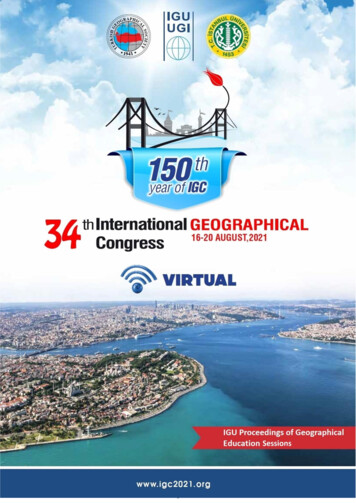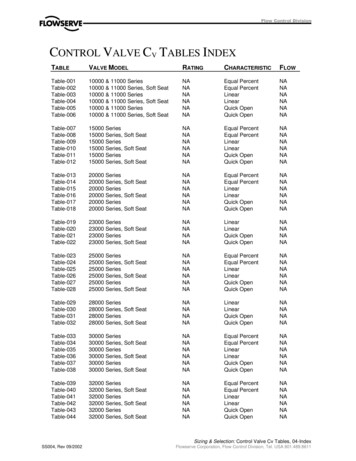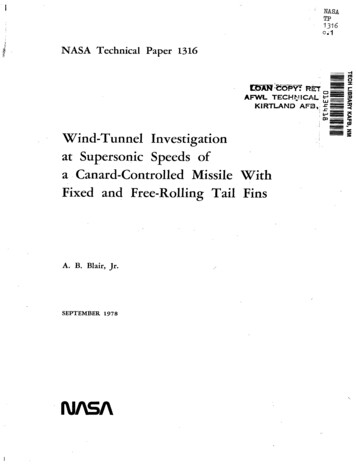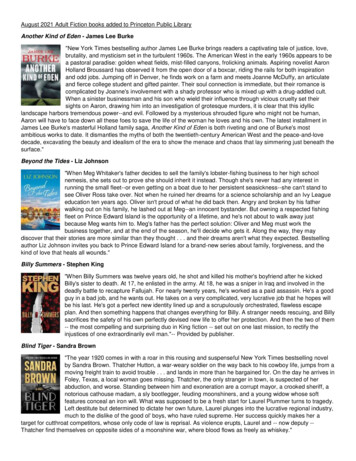
Transcription
16-20 AUGUST,2021 Istanbulth150year of IGCGEOGRAPHY: BridgingtheContinentsIVIRTUAL
16-20 AUGUST,2021 Istanbulth150year of IGCGEOGRAPHY: BridgingtheVIRTUALContinentsTo cite this source:Artvinli, E. (Ed.). (2021). IGU proceedings of geographical education sessions, 34th InternationalGeographical Congress, 16-20 August 2021, ISBN: 978-625-00-0455-5, İstanbul, Türkiye.IGU PROCEEDINGS OF GEOGRAPHICAL EDUCATION SESSIONS16-20 August 2021, Istanbul, Türkiye EditorProf. Dr. Eyüp ARTVİNLİ ISBN: 978-625-00-0455-5First EditionCongresses and meetings / Higher Education/ Geographical EducationPublication date of e-bookDecember, 2021Webhttps://www.igc2020.org/ene-mail: barbaros@istanbul.edu.tr , scientific@igc2021.orgPlaceİstanbul, Türkiye 2021 All responsibility of statements and opinions expressed in the articles/texts in this book isupon their authors. Quotation can be made with the condition of showing reference.
th150year of IGC16-20 AUGUST, 2021VIRTUALORGANIZING COMMITTEEBarbaros Gönençgil (Head)Istanbul University Geography Department, TürkiyeT. Ahmet ErtekIstanbul University Geography Department,TürkiyeTolga GörümIstanbul Technical University Eurasia Institute of Earth Sciences, Türkiyeİhsan ÇiçekAnkara University Geography Department, Türkiyeİhsan BulutAkdeniz University Geography Department, TürkiyePROGRAM BOOKww w. ig c2 0 2 1.o r gII
16-20 AUGUST,2021 Istanbulth150year of IGCGEOGRAPHY: BridgingtheContinents8VIRTUAL
16-20 AUGUST,2021 Istanbulth150year of IGCGEOGRAPHY: BridgingtheContinentsVIRTUALPREFACEDear Colleagues,The organization of the 34th IGC in Istanbul was unanimously accepted at theGeneral Assembly of the International Geography Union, which was held duringthe 32nd International Geography Congress held in Cologne between 26-30August 2012.The 150-year-old IGC will be held in Istanbul, a world city for the first time in its history. This excitesthe local organizing committee and our local geography community. LOC, which has started to worksince 2012, has done all the work for the congress to take place in the best way. Along with the ongoingpreparations in this process, we received more than 2500 applications.However, the Covid-19 pandemic, which affected the whole world, caused our congress to be postponedfor 1 year, as in all events. With the announcement we made in 2020, we shared this postponement withyou. When this unexpected situation continued and the pandemic did not stop, we regretfully decided tohold the congress online together with IGU EC.The excitement of hosting you in Istanbul turned into a bittersweet happiness for us because of the onlinecongress. Although it is a different experience to have the first online IGC in the new world conditions,we tried our best to set an example for future congresses.We would like to thank all our colleagues, commission chairs, IGU EC who stood by us during this difficultprocess, and our presidents Ronald F. Abler, Vladimir Kolosov, Yukio Himiyama and Micheal E. Meadows,who have always supported us.Our deepest condolences to RB Sigh, who passed away untimely a short time ago.Hoping to meet in Istanbul at another congress to be held face to face Prof. Dr. Barbaros GÖNENÇGİLHead of the Local Organizing Committee
16-20 AUGUST,2021 Istanbulth150year of IGCGEOGRAPHY: BridgingtheContinentsVIRTUALPREFACEDear Colleagues,At the Regional Geography Congress held in Tel Aviv in 2010 on behalf of the TurkishGeographical Society (TGS), I had submitted a petition to former IGU President Prof.Dr. Ron ABLER that we were nominated for the International Geographical Congressto be held in the coming years of the International Geographical Union (IGU). About10-11 years have passed on this date. Two major international geography congresseswere held in Cologne and Beijing, and we even attended regional geographyconferences held in Santiago, Krakow, Moscow and Kyoto.At the IGU-General Assembly in Cologne in 2012, the “34th International Geography Congress”, which weentered as the only candidate, to be held in Turkey in 2020 was unanimously approved by the votes of47 countries.In 2016, we took the IGU flag from China and brought it to Turkey as a representative at the closingceremony of the “33rd International Geography Congress” in Beijing. Meanwhile, the Vice President ofthe Turkish Geographical Society Prof. Dr. Barbaros GÖNENÇGİL was elected as the Vice President ofIGU with high votes. This is for us, as the value given to Turkey, together with the “17th InternationalGeography Olympiads”, it was the third great honour and happiness.Both “17th International Geography Olympics”, as well as the “34th International Geography Congress”,were postponed to 2021 by the decision of the TGS and IGU Boards members due to the rapidly spreadingCovid-19 flu epidemic in the world and the loss of millions of people and it was decided to be held virtual.This congress, which will be held in the city of Istanbul, which was set out with the motto of “Geography:Bridging the Continents” and spread over two continents between Asia and Europe, will go down in IGUhistory when it is held on virtual, and thus will be a first.We are thankful to all the Turkish delegation who contributed to the organization of the congress, to theIstanbul University Rectorate, IGU Board members, members of Commissions, country representatives,session chairs and presenters, to the former IGU Presidents Prof’s ABLER, KOLOSSOV, HIMIYAMA andIGU President Prof. Dr. Mike MEADOWS who have always been supportive to us.I wish the Covid-19 flu pandemic to be completely eliminated from the world and a successful GeographyCongress to pass in health, happiness and peace.Assoc. Prof. T. Ahmet ERTEKPresident of Turkish Geographical Society
16-20 AUGUST,2021 Istanbulth150year of IGCGEOGRAPHY: BridgingtheContinentsVIRTUALPREFACEDear Colleagues,After a postponement by one year, the 34th International Geographical Congress isfinally taking place and nine years of preparation and planning can now bear fruit!Of course, due to the ongoing COVID-19 pandemic the Congress is taking place inonline mode only – although the local organizing committee has gone to considerablelengths to try to ensure that the experience will be as ‘real’ as anything ‘virtual’ can possibly be.The postponement of the original Congress to 2021 at least allows us to reflect on the history of thediscipline – as it is 150 years exactly since the very first International Geographical Congress took place,in Antwerp, Belgium from 14th to 22nd August 1871.It was at this congress that a proposal was made to establish Greenwich as the prime meridian, althoughthis was only finally accepted 13 years later. Admittedly, these days our discussions may not lead toanything quite so fundamental, but we can be sure that the papers presented here are indicative of thediverse but crucially relevant nature of Geography today and that the lively discussions and networkingwill offer great opportunities to further develop and orientate our work towards meeting the enormouslocal, regional and global challenges we currently face – not least the coronavirus crisis itself.I fervently h o p e that the virtual connections we make here will blossom and culminate in our meetingface-to-face to celebrate the centennial of the International Geographical Union in Paris this time nextyear. For now, I wish to thank the participants for their contributions and to congratulate the localorganizing team on their tremendous efforts in bringing us together virtually. I am sure that the eventwill be heralded as a great success despite the ongoing constraints.Prof. Mike MEADOWSIGU President
16-20 AUGUST,2021 Istanbulth150year of IGCGEOGRAPHY: BridgingtheContinentsVIRTUALKEYNOTE SPEAKERS16th August 2021, 13:45 - 14:45 GMTKeynote Lecture 1Building Climate Resilient CommunitiesPROF. GORDON MCBEAN17th August 2021, 13:45 - 14:45 GMTKeynote Lecture 2Bridging Geography and Geology in the AnthropocenePROF. EDUARDO DE MULDER18th August 2021, 10:00 - 11:00 GMTKeynote Lecture 3Entre local et global : l’habitat en Europe médiane Between local and global: housing inCentral and Eastern EuropeLYDIA COUDROY DE LILLE18th August 2021, 13:45 - 14:45 GMTKeynote Lecture 4Geographical Approaches to Evaluating Global Environmental Programs in theAge of SustainabilityDR. JUHA I. UITTO19th August 2021, 10:00 - 11:00 GMTKeynote Lecture 5Bridging Cultures: How Did the Foreign Authors of Some Chinese Geography Books See China?PROF. SHANGYI ZHOU19th August 2021, 13:45 - 14:45 GMTKeynote Lecture 6TSUNAMIS: How to Develop a Tsunami Resilient SocietyDR. HARSH GUPTA20th August 2021, 10:00 - 11:00 GMTKeynote Lecture 7Geographies of the Anthropocene: Sustainable Development and the role of InternationalGeographical UnionPROF. MIKE MEADOWS
CONTENTSPapersHow to Use Landscape Images in Geography Textbooks: Example of Some Countries . 11Eyüp Artvinli /Eskişehir Osmangazi University, TürkiyeTeaching Geography at the Universities in Russia: Current Challenges and Prospects . 17Nina N. Alekseeva, Julia Greenfeld and Vladimir E. Shuvalov/ Faculty of Geography,Lomonosov Moscow State University, RussiaSpatial Cognition Level and Geographical Education in Children . 28Leyla Dönmez / Eskişehir Osmangazi University, TürkiyeChanging US Educational landscape in geography . 35Melvin Arthur Johnson/ University of Wisconsin Green Bay, USADeveloping Map Literacy of University Students with the Fieldwork: An Example ofHuman Geography Course . 46Eyüp Artvinli /Eskişehir Osmangazi University, TürkiyeImproving on the Inclusivity of History Textbooks with Environmental History:The Case of The Araucanía Occupation (Chile 1859-1884) . 52Matías González-Marilicán 1, Elizabeth Montanares 2, Daniel LLancavil 2,Gabriela Vásquez 3/ University of Bristol Department of History Brixham-United Kingdom 1,Universidad Católica de Temuco Faculty of Education 2, Universidad Andrés Bello Faculty ofEducation and Social Science, Chile 3The Role of Geography Education in Disaster Risk Reduction: Evidence from Indonesia . 53Furqan Ishak Aksa Aksa, Ramdan Afrian Afrian / Samudra University GeographyEducation Langsa, IndonesiaGeographical Outdoor Education . 54Andrea Guaran/ University of Udine, ItalyPreservice Geography Teachers’ Assessment of the Impact of Scaffolds inProblem-Based Learning Activities on Their Learning . 55Aubrey Golightly North-West University, South AfricaTeaching and learning sustainable development with fieldwork: A practicalexample of geography education in Macau . 56Tat In TAM/ Geography and Education Research Association of Macau, ChinaAnalysis of Social Studies Course in Terms of Geographical Education According toLearning Styles in the Curriculum . 75Leyla Dönmez / Eskişehir Osmangazi University, TürkiyeA Review of Geographical Information Systems Content in The GeographyCurriculum Of Pre-Service Student Teachers in South Africa . 81Maureen Kapute, North West University, South AfricaSynergies Between Geographical Thinking, Citizen Training and Virtual Education,For The Understanding-Management of Problems of The Society-Territory Complex . 82
Doctorado Interinstitucional en Educación-DIE-Universidad Distrital Francisco José deCaldas-UDFJC, Bogotá, ColombiaHow Apt is the Geography Curriculum to Which Learning Styles of Students?.93Eyüp Artvinli /Eskişehir Osmangazi University, TürkiyeImpressions And Beliefs on Landscapes: Development of an Innovative andIntegrated Learning Methodology for Secondary School Education . 102Patricia Honvári , Tamás Hardi / Centre for Economic and Regional Studies, HungaryThe Roles of The University and Academics in Meeting the Goals and Needs ofSociety . .103Mihkel Kangur Liisa Puusepp; Toomas Trapido / Tallinn University, EstonianGeographical Society, EstoniaThe South African National Geography Olympiad: A Growing OnlineOlympiad Milton Milaras the University of South Africa .104Tracey Mckay / The University of South AfricaDevelopment of Map Skills of Students with Orienteering Social StudiesCourse in Secondary School . 105Eyüp Artvinli /Eskişehir Osmangazi University, TürkiyeApplicability of the Acquisitions in the 2018 Geography CourseCurriculum in Terms of Geographic Information Systems . .110Leyla Dönmez / Eskişehir Osmangazi University, Türkiye10
How to Use Landscape Images in Geography Textbooks: Example of Some CountriesProf. Dr. Eyüp ArtvinliEskişehir Osmangazi University, Faculty of Education, Eskişehir, TürkiyeThe aim of this study is to compare the landscape images in geography textbooks ofTurkey and some other countries. Comparison will give an understanding about thepresentation of different landscapes of different countries and cultures of people.Geographical imagination of landscape often gives an idea to people about that place orphenomena and it create a positive or negative opinion about that place, city or country. Themethodology of this research based on content analysis. As the first step the landscapephotos are determined and categorized in the geography textbooks of countries. In this wayit can be possible to demonstrate the kinds of landscapes imagination to people in countries.After those researchers focused on to determine about to find how to interpret inside of thetexts. In this way it is possible to link to different appearance of physio-geography dimensionin countries. It is concluded that landscape imagination given in geography textbooks havedifferent effect in different countries and people. Thus, it is important to choose rightlandscape photos in geography textbook in order to give right message and leave a positiveimagination for the people. According to using landscape photos in geography textbooksoften reflect the term of social life and viewpoint of that society about human-natureinteraction and relations between them. In this way, by comparing or analyzing geographytextbooks, it can be observed and conclude the changes and development of the ideas ofsocieties about nature and environment and its use by human.IntroductionThe significance of students’ imagination extends beyond scientific interest. Youngpeople are the future decision makers, hence it is essential to know what kind of images theyare exposed to, and how they view and understand the world, since people behaveaccording to how they see the world and not how the world really is (Schlitz, Vieten, andMiller 2010).11
Landscape, despite being a key analytical concept in several social and environmentalsciences (Wylie et al. 2009), lacks clarity and unambiguity, mainly because it conveys acomplex and multivocal relationship between the natural environment and human society. Itis both the result of this interaction and concurrently the process itself. This dynamic aspectwas emphasized by Mitchell (1994), who wittily explained landscape to be more a verb thana noun. Connected to a landscape’s structural aspect, one must recognize both tangible andintangible elements. Among numerous scholarly orientations (Shaw and Oldfield 2007), thatof Cosgrove (1998) and Cosgrove and Daniels (1988) is relevant to this paper: landscape as away of seeing and representing the world. Cosgrove (2003) further elaborates: ‘Landscapethus denotes primarily geography as it is seen, imaged and imagined.’ Implicit in thisstatement is the representation of landscapes which can take a myriad of (not only) visualforms with photography having a prominent role.Photographs have been effectively and widely used in research since the advent ofphotography and have proved their importance for geography’s scholarly paradigm. Thefundamental use of photography is for gathering and evidencing information(Schwartz 1996). Equally important is its role in constructing and transmitting geographicalknowledge (Rose 2008), thereby having a long tradition in schooling (Hall 2015). It has alsobeen a powerful research method or practice (Cooper 2017). Moreover, the authority or‘constructive’ power of photography (Van Leeuven and Jewitt 2004) goes far beyond theclassroom into the general sphere of communicating ideas about the world and shapingone’s worldview.However, it was only at the end of the twentieth century that photographs became asubject of geographical inquiry. Its usefulness as a research subject is based on the fact thatphotographs (including scientifically conceived photographs) have ‘layers of meaning beyondthe visual facts presented in the image themselves’ (Schwartz 1996). One of the mostinfluential analyses of photography is Lutz and Collins (1993) content analysis of the NationalGeographic journal. Further impetus was given by applying the concept of geographicalimagination and the visual turn in humanities which brought to light visuality andphotography as a primary source for examination in cultural and historical studies12
(Cosgrove 2006; Rose 2001). Photo elicitation methods have proved to be effective in gainingan insight into children’s spatial perceptions (Leonard and McKnight 2015; Pyyry 2015).Purpose of the Present StudyThe aim of this study is to compare the landscape images in geography textbooks ofTurkey and some other countries. Comparison will give an understanding about thepresentation of different landscapes of different countries and cultures of people.Geographical imagination of landscape often gives an idea to people about that place orphenomena, and it create a positive or negative opinion about that place, city or country.The methodology of this research based on content analysis. As the first step the landscapephotos are determined and categorized in the geography textbooks of countries. In this wayit can be possible to demonstrate the kinds of landscapes imagination to people in countries.MethodSampleIn this section, the research method, study group, data collection tool and itsapplication and the techniques used in data processing and analysis are discussed. Thisresearch occurs in a qualitative pattern. Qualitative research can be defined as research inwhich qualitative data collection methods are used, such as observation, interview anddocument analysis; and a process is followed for the realistic and holistic presentation ofperceptions and events in a natural environment (Yıldırım and Şimşek, 2016, p. 45). Researchdata was obtained through document analysis, which is a qualitative research methodcovering the analysis of written materials containing information about facts and events(Wachter, 2010).In this study, research data was collected by document analysis technique and the datawas analyzed by content analysis. Content analysis is defined as "the systematic reading of abody of texts, images, and symbolic matter, not necessarily from an author's or user'sperspective" (Wachter, 2010).13
DesignIn this study, research data was collected by document analysis technique and the datawas analyzed by content analysis. Content analysis is defined as "the systematic reading of abody of texts, images, and symbolic matter, not necessarily from an author's or user'sperspective" (Wachter, 2010).ResultsIt is noteworthy that there are few images used in textbooks taught in Turkey. Inparticular, as the age level decreases, the earth shapes of the images should take up morespace, while on the contrary, pages with fewer images and more writing have been placed.However, when examining Australian textbooks, the importance given to visuals increased asthe age level decreased. Again, when studying textbooks in the UK, it seems that the pagesof landforms are more actively involved.As the first step the landscape photos are determined and categorized in thegeography textbooks of countries. In this way it can be possible to demonstrate the kinds oflandscapes imagination to people in countries. After those researchers focused on todetermine about to find how to interpret inside of the texts. In this way it is possible to linkto different appearance of physio-geography dimension in countries. It is concluded thatlandscape imagination given in geography textbooks have different effect in differentcountries and people. Thus, it is important to choose right landscape photos in geographytextbook in order to give right message and leave a positive imagination for the people.ConclusionIt is concluded that landscape imagination given in geography textbooks havedifferent effect in different countries and people. Thus, it is important to choose rightlandscape photos in geography textbook in order to give right message and leave a positiveimagination for the people. According to using landscape photos in geography textbooksoften reflect the term of social life and viewpoint of that society about human-natureinteraction and relations between them. In this way, by comparing or analyzing geography14
textbooks, it can be observed and conclude the changes and development of the ideas ofsocieties about nature and environment and its use by human.ReferencesCooper, L.(2017). “Lost in Translation: Exploring Childhood Identity Using PhotoElicitation.” Children’s Geographies 15 (6): 625–637.Cosgrove, D., and Daniels, s.(1988). The Iconography of Landscape: Essays on the SymbolicRepresentation, Design and use of Past Environments. Cambridge: CambridgeUniversity Press.Cosgrove, Denis. 1998. Social Formation and Symbolic Landscape. Madison: University ofWisconsin Press.Cosgrove, D. (2003). “Landscape and the European Sense of Sight - Eyeing Nature.”In Handbook of Cultural Geography, edited by Kay Anderson, Mona Domosh, StevePile, and Nigel Thrift, 249–268. London: SAGE Publications Ltd. Accessed June 3 2018.Hall, T.( 2015). “Reframing Photographic Research Methods in Human Geography: A LongTerm Reflection.” Journal of Geography in Higher Education 39 (3): 328–342.Leonard, M., and Martina M. (2015). “Look and Tell: Using Photo-Elicitation Methods withTeenagers.” Children’s Geographies 13 (6): 629–642.Lutz, A., and Jane L. (1993). Reading National Geographic. Chicago: University of ChicagoPress.Mitchell, Thomas W. J. (1994). Picture Theory: Essays on Verbal and Visual Representation.London: The University of Chicago Press.Pyyry, N. (2015). “‘Sensing With’ Photography and ‘Thinking With’ Photographs in ResearchInto Teenage Girls’ Hanging out.” Children’s Geographies 13 (2): 149–163.Rose, G. (2008). “Using Photographs as Illustrations in Human Geography.” Journal ofGeography in Higher Education 32 (1): 151–160.15
Schlitz, M., Cassandra V., and Elisabeth M. (2010). “Worldview Transformation and theDevelopment of Social Consciousness.” Journal of Consciousness Studies 17 (7,8): 18–36.Shaw, D. B., and Jonathan D.,( 2007). “Landscape Science: a Russian GeographicalTradition.” Annals of the Association of American Geographers 97 (1): 111–126.Schwartz, Joan M. (1996). “The Geography Lesson: Photographs and the Construction ofImaginative Geographies.” Journal of Historical Geography 22 (1): 16–45.Van L., , and Carey, j., (2004). Handbook on Visual Analysis. London: Sage Publications.Wachter, C. A. (2010). Understanding and responding to concerns related to giftedness: Astudy of CACREP-accredited programs. Journal for Education of the Gifted, 33, 390–393.Wylie, J.,(2009). “Landscape.” In Dictionary of Human Geography, edited by Derek Gregory,409–411. Oxford: Wiley-Blackwell.Yıldırım, A., & Şimşek, H. (2016). Sosyal bilimlerde nitel araştırma yöntemleri (Genişletilmiş 10.Baskı). Ankara: Seçkin Yayıncılık.16
Teaching Geography at the Universities in Russia: Current Challenges and ProspectsNina N. Alekseeva1, Julia Greenfeld2 and Vladimir E. Shuvalov31Faculty of Geography, Lomonosov Moscow State UniversityFaculty of Geography, Lomonosov Moscow State University3Faculty of Geography, Lomonosov Moscow State University2Correspondence concerning this article should be addressed to Nina N. Alekseeva, Federaleducational and methodological association on Earth Sciences, Faculty of Geography,Lomonosov Moscow State University, Leninskie Gory, 1, Moscow, 119991, RussianFederation. Email: nalex01@mail.ru, umo@geogr.msu.ru.The paper discusses the status of university Geography in the Russian Federation. Thestudy was based on the inventory of the web-sites of about 50 universities and questioningthe staff from selected leading universities. There are more than 50 universities in Russiaoffering programs in Geography, but there is no distinct profession “Geographer” in thenational Classification of Occupations (2014) as well as in International StandardClassification of Occupations (ISCO-2008). The gradual loss of position of Geographyprograms at Russian universities in favor of Environmental studies, Tourism, etc. is discussed.The features of educational standards are characterized, indicating the main professionalfunctions and skills (competencies) of geographers, as well as professional profiling. There isevident shift to “generic” geographer training at the majority of Russian universities, withfew of them having numerous specific majors. The paper suggests some measures needed toeffective adaptation of Geography at the universities facing the increasing competition withother areas of education.Keywords: Geography, undergraduate and postgraduate programs, competences, curricula,Russia.IntroductionThe training of geographers at Russian universities has been going on for more thantwo centuries. Geography as a university science was recognized in Russia by the Charter ofMoscow university since 1804 (Soloviev, 1964). The first geographical departments wereestablished at Moscow University in 1804 and in St. Petersburg in 1819. In the middle of the17
last century 29 universities of the USSR trained geographers and 68 pedagogical institutestrained geography teachers. The number of geographers who graduated from Sovietuniversities, as of the 1950s – 1970s, numbered in the thousands a year.Currently, 52 universities in 48 regions of the Russian Federation provide education ingeography at the bachelor's level on a regular or periodic basis. Postgraduate training inGeography is being implemented in more than 30 universities. Currently, admission toGeography programs in many universities is not carried out every year.Average annual recruitment 2016–2020 for budgetary places (full-time education) was about1200-1450 people for undergraduate programs and 630-970 people to the master's degreeprograms in Geography, with a tendency to reduce admission to both levels of education(Table 1). The admission to educational programs in Geography, by decision of the universitymanagement, is often reduced in favor of other areas of study, such as EnvironmentalSciences or Tourism, the field of employment of which is more clearly defined and for whosegraduates there is a demand from the labor market in a particular region of the country. Thechange in the status of geography in Russian universities also occurs as a result of highereducation reforms at federal level, which do not always have a positive effect on thecurriculum.Purpose of the present study was to summarize the current status of the universitygeographical education in Russia in the context of constantly changing structure of higherprofessional education and emerging demand for the “generic” geographer.Materials and methodData collection implied the inventory of web-sites of more than 50 divisions of theuniversities all over Russia, with educational programs in Geography, as well as questioningof the staff from leading Russian universities. The questionnaire included 24 questionsabout recruitment, curriculum structure, practices and internships, employment ofgraduates, workload on teachers, etc. Data base of Federal educational and methodologicalassociation on Earth Sciences was used.18
Changing Status of the Geography Divisions at the UniversitiesOver the past 20 years, there have been cardinal institutional changes in the structuraldivisions of universities with educational programs on Geography. As part of the ongoingreorganizations and consolidations in Russian universities almost half of the faculties ofGeography became part of the joint Institutes, in the overwhelming majority of cases havinglost their independent status. Out of 52 universities, only 8 universities have noweducational and scientific structural subdivisions with the title Geography proper (as "Facultyof Geography", "Faculty of Geography" or "Institute of Geography"). More often Geographyis present in the Natural Sciences or Earth Sciences institutes or in combination with otherdisciplines. Figure 1 depicts the ag cloud of the titles of faculties and institutes of the RussianFederation universities with educational programs in Geography.The loss of the previously won university status and, in general, positions in most universitiesin Russia led to the transition of geography from the faculty level to the level ofdepartments, where it began to be organizationally combined with other areas of training(Alekseeva et al, 2015). For example, at the Kazan Federal University, there is theDepartment of Geography and Cartography, at the Kemerovo State University - Departmentof Geology and Geography,
16-20 AUGUST,2021 Istanbul 150 th GEOGRAPHY: VIRTUAL Bridging the Continents year of IGC To cite this source: Artvinli, E. (Ed.). (2021). IGU proceedings of geographical education sessions, 34th International Geographical Congress, 16-20










